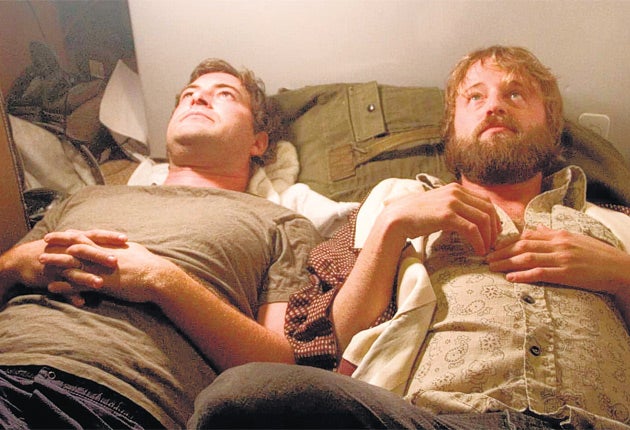Mumblecore - A genre worth shouting about
Mumblecore's low-budget, relationship-centred movies make it the only independent film movement to have had recent success in the US. Kaleem Aftab reports

Your support helps us to tell the story
From reproductive rights to climate change to Big Tech, The Independent is on the ground when the story is developing. Whether it's investigating the financials of Elon Musk's pro-Trump PAC or producing our latest documentary, 'The A Word', which shines a light on the American women fighting for reproductive rights, we know how important it is to parse out the facts from the messaging.
At such a critical moment in US history, we need reporters on the ground. Your donation allows us to keep sending journalists to speak to both sides of the story.
The Independent is trusted by Americans across the entire political spectrum. And unlike many other quality news outlets, we choose not to lock Americans out of our reporting and analysis with paywalls. We believe quality journalism should be available to everyone, paid for by those who can afford it.
Your support makes all the difference.It's more than just the physical resemblance to Francis Ford Coppola that has seen Andrew Bujalski anointed the "Godfather of Mumblecore". Just like the Apocalypse Now director, the 32-year-old Boston-born director is at the forefront of a generation of film-makers who have turned their back on Hollywood and the traditional way of doing things.
Mumblecore is the only movement that has been on the rise at a time when the American independent movie scene has imploded, with major studios closing their subsidiaries aimed at the independent sector and private funding for small projects drying up.
The characteristics of Mumblecore are that they are ultra-low-budget movies, they are character-driven relationship stories, the action is shot over a few days, there is plenty of improvisation, and the cast is usually made up of non-professional actors playing a version of themselves. The movement is also director-led, with other leading lights being Lynn Shelton, Joe Swanberg, and Jay and Mark Duplass.
Heading this group is Bujalski, and his latest work, Beeswax, is, on the surface, a typical example of the genre. This movie deals with the fractured relationship of the owners of a vintage boutique store in Austin, the Texan capital that has become America's hipster central. The owners are thirtyish twins who are played by actual twin sisters, Bujalski's friends Tilly and Maggie Hatcher.
Tilly is in a wheelchair, which causes a certain unmentioned stress in their relationship, especially as she's the brain behind the store while her sister just seems to attract chaos.
Those expecting a traditional three-act structure and a plot revolving around moments of confrontation will be disappointed. As with the other films in the movement that started with his 2002 film, Funny Ha Ha, Beeswax is a slice-of-life drama. The open-ended finale suggests that these characters continue to live after the final credits have rolled. This is anti-Hollywood at its finest.
Beeswax also marks the moment when the Mumblecore generation may finally cross over into the mainstream. So far, the movement has been so independent that, unless you're a cineaste who frequents film festivals, it's unlikely that Mumblecore has registered on your Richter scale.
It was in 2005 that the term Mumblecore was coined after the appearance of three movies at the increasingly significant South by Southwest Film Festival in Austin, Texas. When the sound engineer Eric Masunaga was asked about what the unifying factor of Joe Swanberg's Kissing on the Mouth was, Bujalski's second film, Mutual Appreciation, and Jay and Mark Duplass's The Puffy Chair, he cited the mumbling characters.
Unsurprisingly, Mumblecore is a label that the group have grown to hate. Bujalski argues: "It was something said as a joke that has been taken out of context."
It doesn't help that the movement's detractors use Mumblecore as a pejorative term.
Yet it seems that the Mumblecore film-makers are about to have the last laugh, as more and more film-makers have come around to their way of thinking, and the popularity of their work is finally escaping the film-festival ghetto, and, more pertinently, Hollywood is now looking to jump on to the film-makers' bandwagon.
But it's been in the past 12 months that the movement has really taken centre stage. The Seattle-based Lynn Shelton made the hit film Humpday, which played at Cannes, about two male best friends who agree in a drunken moment to star in a homosexual porn film together.
It was shot in 10 days around her favourite Seattle haunts and starred the fellow genre director Mark Duplass and Joshua Leonard, the star of The Blair Witch Project, the film that can certainly claim to be the original DIY blockbuster hit.
Amusingly, the success of Mumblecore has led to some American commentators proclaiming the movement's death, but this seems to be more a knee-jerk reaction to the negativity that the world of Mumblecore has generated. The facts are rather different.
It is becoming clear that the movement is, after a two-decade hiatus, finally providing the American movie scene with a new generation of film-makers to get excited about.
Join our commenting forum
Join thought-provoking conversations, follow other Independent readers and see their replies
Comments